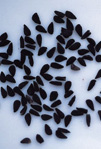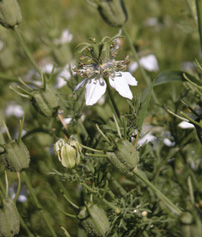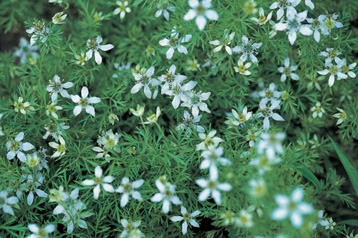

Black cumin seeds purchased in the herb market in Amman, Jordan.
“DOES HE NOT FINALLY PLANT his seeds—black cummin, cummin, wheat, barley, and emmer wheat—each in its proper way, and each in its proper place? The farmer knows just what to do, for God has given him understanding. A heavy sledge is never used to thresh black cummin; rather, it is beaten with a light stick. A threshing wheel is never rolled on cummin; instead, it is beaten lightly with a flail” (Isaiah 28:25–28, NLT).
The Hebrew word qetsach, used in this verse, which is translated “fitches” in the KJV, “caraway” in the NIV, and “dill” in the JND, is most accurately translated as black cumin in the NLT (the archaic spelling “cummin” is used in many translations). The word is found nowhere else in the Bible. There is little archaeological basis for translating “black cummin” as caraway (NIV). Caraway is not a Middle East plant, another indication of European translators’ intercalation of plants known to them into the ancient texts. Dill is a possibility, though the description of the herb in the verse, implying a sharp, pointed beak, comports better with black cumin. The same word, getsach, is used for unrelated plants with similar architecture (pointed structures) in other scriptures (Ezekiel 4:9). In Old English, “fitch” may be related to vetch (species of the genus Vicia), a wellknown legume fodder crop.
Black cumin is Nigella sativa and no relation to the well-known herb cumin, Cuminum cyminum. In the Middle East, black cumin is planted in the winter and produces attractive flowers in the spring. This and related species are grown in the garden for their unusual flowers.

Black cumin flowers with developing capsules evident in May, in a field near Aleppo, Syria.

Black cumin flowers. Several related species of this plant are grown as garden subjects, the most popular having the intriguing common name “love-in-a-mist.”
On Arab farms, I have observed farmers threshing the seeds of black cumin from the fruits by beating the dried plants with a stick in just the manner recorded in Isaiah 28. The jet-black seeds are pungent, with a distinct flavor. Black cumin is most frequently used to flavor bread, cakes, or other baked goods. The spice is either incorporated into the dough or sprinkled on top during or after baking.
Black cumin is one of the most widely used spices in the Middle East and has been for thousands of years. Black cumin seeds were found in the tomb of Tutankhamun (1333–1324 BC) (de Vartavan et al. 1997). Medicinal uses of the seeds have received much attention recently, especially for tumor suppression.
Like other spices in the Bible, black cumin is popular and is becoming increasingly available. The biblical narrative, however, deals more with the metaphor of the farmer taking different actions at different stages of the crop’s development, all with an eye toward the harvest—a frequent image in the Bible. Pedagogically, this was no doubt clear to ancient hearers of the scripture, who would be familiar with the plants and the cultivating processes.